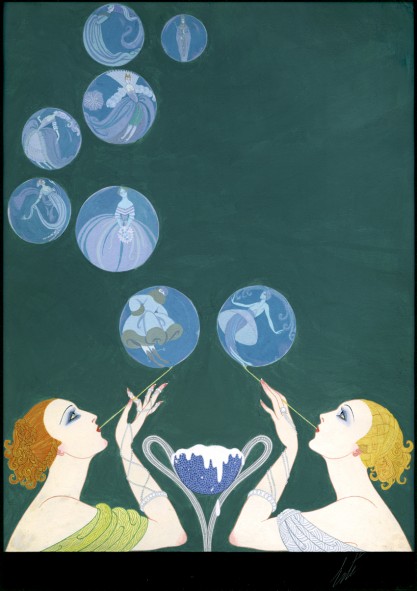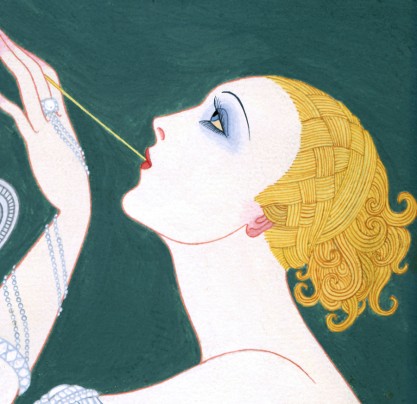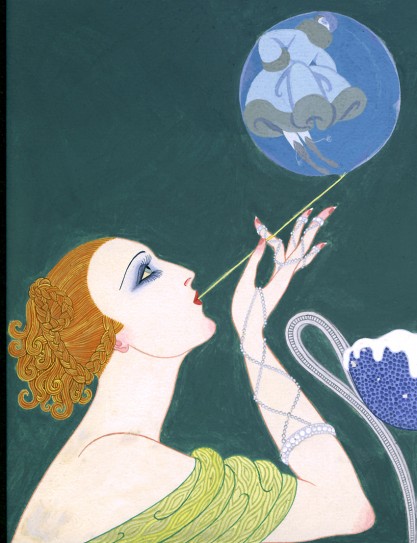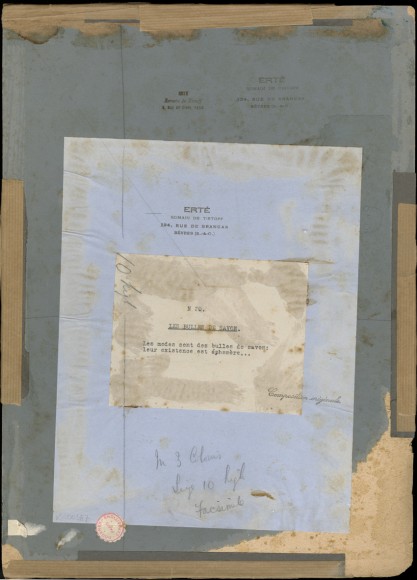


One of the earliest existing examples of Erté’s Art Deco cover illustrations for Harper’s Bazar, this gouache painting appeared in November 1918 under the title Les Bulles de Savon. The image showcases two chic Parisian ladies, icons of the new modernist turn, blowing bubbles in which are seen a parade of Edwardian and Art Nouveau fashions. A whimsical yet moving comment on the passage of time, with the artist’s incredible eye for detail, texture, and color. An early and iconic masterwork by Erté, whose name is synonymous with Art Deco. A limited edition of 300 signed screen-prints of this image appeared in the 1980s, a move which speaks to the enduring appeal of this artwork. This scarce surviving original gouache painting by Erté from his career with Harper’s Bazaar has been in a private collection in the United Kingdom since 1982, when it was offered by Sotheby’s, London.
Gouache cover painting remains in pristine condition with vivid uncompromised coloring and surfaces. Housed is a custom made museum qualilty gesso frame created by our colleagues at The Dream Gardener in Seattle. We are currently searching for a cover or complete edition of the published magazine, in the meantime, we have included for reference a screen shot of the cover as seen in the microfilm collection of the Minneapolis Public Library.




Titled on verso Les Bulles de Savon, which translates to “The Soap Bubbles”. Typewritten caption reads “Les modes sont des bulles de savon leur existence est ephemere“ which translates to English as follows: “The worlds are soap bubbles their existence is ephemeral“. Along with the title and caption, the verso shows assorted notations, artist stamps, and handwritten publication notations.



A short biography of Erté, by Grace Walsh:
The artist known as “Erté” was born Romain de Tirtoff in Saint Petersburg, Russia in 1892, the son of an Imperial Navy officer and a member of the Russian social elite. From a young age, he developed a fascination with his father’s collection of Persian miniatures that would influence his style for years, and which inspired him to pursue a career in the arts and fashion. He would go on to become one of the most recognizable illustrators and designers of the early 20th century.

After moving to Paris at the age of 18, against his father’s wish that he follow the family trade of military service under the czar, he adopted a new name: “Erté” or the French pronunciation of his initials “R.T.” He worked under noted couturier and costume designer Paul Poiret, whose flowing orientalist designs were talking Paris by storm on the stage of Diaghilev’s Ballets Russes. Diaghilev once gave Erte the soundest business advice he ever got, “Never refuse money,” Diaghilev reportedly told the young Erte. It is quite evident that the artist never did. Erté’s own exotic aesthetic and connections with the fashion industry earned him a position with Harper’s Bazaar, where he translated his talents as a designer and clothier into illustrating around two hundred covers for the prestigious title spanning nearly three decades.
Though working primarily as an illustrator for Harper’s Bazaar, Erté remained faithful to his roots in clothing and costume design. With one foot already in the fashion world, Erté became a regular in the industry not only as a graphic designer, but also as a costume designer and set designer for theater, most notably the Folies-Bergères in Paris. He also costumed a number of the most recognizable names of the era, including Lillian Gish, Joan Crawford, Ana Pavlova, and even the infamous Mata Hari, before her death in 1917. His affiliation with the growing film industry presented him with opportunities not only in Paris, but in New York and Hollywood, where he worked for MGM Studios as the costume designer and art director for numerous films, including Bright Lights (1925) and Dance Madness (1926).
After falling into mild obscurity during World War II and the following years, he experienced a renewed popularity in the 1970s and 1980s spurred by a renewed popularity of Art Deco styles. During this second career, he produced an enormous number of limited editions of his earlier illustrations, but also a range of bronze sculptures that exhibited the same stylistic hallmarks of his drawings: a sense of elegance and sensitivity to clothing and movement. He died in Paris in 1990 at the age of 97. His work has been featured and is in the collections of some of the world’s most prestigious institutions including the Smithsonian, New York’s Metropolitan Museum of Art and Museum of Modern Art, and London’s Victoria and Albert Museum.


